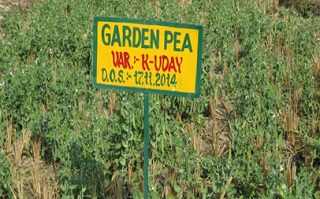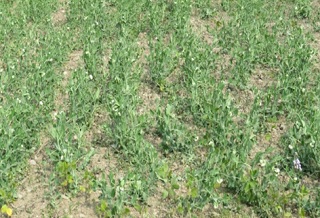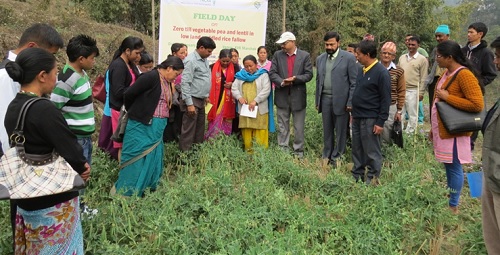Success Story on “No Tillage of Vegetable Pea in Rice Fallow”
Nandok village in East district of Sikkim is climatically vulnerable village and frequently affected by acute water scarcity during Rabi season. During 2014-15, 2298.90 mm rainfall was received during April to October but from November to March total precipitation was 83.15 mm only. Climate change has caused variations in rainfall pattern leading to uncertainty and deficit rainwater resulting in acute moisture stress during November to February. Similarly, the mean annual air temperature increase over the last three decades has resulted in increased evaporation rate. The soils have inherent low water holding capacity. In the village people are dependent on agriculture and allied activities. Generally, most of the farmers in the village practiced mono-cropping system of rice cultivation and their field remained fallow during Rabi season. Cultivating the second crop was not an option due to uncertainty of rain and lack of irrigation infrastructure. Therefore, in order to enhance the farm income and livelihood status of the farming community, KVK-East Sikkim, ICAR, Ranipool made interventions for cultivation of vegetable pea under no tillage technology at Nandok village under NICRA (Technology Demonstration Component) project to enhance the cropping intensity of the village by utilizing the residual soil moisture of Kharif rice during 2014-15. The technology not only saved energy but also helped in enriching the soil health by improved soil organic carbon (SOC) status due to non-disturbance of soil.
Initially, training-cum-demonstration programme on “No Tillage Cultivation of Vegetable Pea in Rice fallow” was organized at Nandok village. A progressive farmer Mr. Gokul Rai in the Nandok village learnt about the technology and volunteered to bring about 0.5 ha of his land under no tillage cultivation of vegetable pea. Previously he followed only mono-cropping system of rice cultivation while the land remained fallow after the harvest of Kharif rice. Thereafter, demonstration of no till vegetable pea cultivation was evaluated on his land and compared with crops grown under conventional tillage. The growth and yield parameters in vegetable pea were better in no tillage than conventional tillage due to timely sowing and benefit of residual soil moisture after rice harvest.
KVK, East Sikkim organized capacity building programmes during demonstration for the successful intervention of no tillage technology by imparting skill-based knowledge for augmenting vegetable pea production under NICRA adopted cluster village for sustainable livelihood security during Rabi 2014.
Impact of Resource Conservation Technology
After the intervention, the progressive farmer got 12.9 per cent higher green pod yield under the resource conservation practices over the traditional practices. The resource conservation technology of vegetable pea cultivation in the rice fallow enhanced the cropping intensity of the area to the tune of 200 per cent.
Cropping pattern Av. yield(q/ha)
Gross cost(Rs./ha)
Gross income (Rs./ha) Net income(Rs./ha)
B:C ratio Rice (var. Thulo Attey (local cv.)) 27.8 28,300 44,480 16,180 1.57 Pea (var. Kashi Udai)
(Green pod) Conventional tillage
59.6 43,200 1,19,200 76,000 2.76 Pea (Var. Kashi Udai) No tillage 68.4 39,780 1,36,800 97,020 3.44 Conclusion
After successful implementation of the technology, farmers in the village were highly impressed and motivated by the no tillage cultivation practice due to its cost effectiveness, less labour consumption, high energy saving and higher net income with efficient utilization of available resources.The present success story in the farmers’ field indicates that vegetable pea under no tillage may be a climate resilient crop option which can be grown with the residual soil moisture. By adopting no tillage, the farmers may increase the productivity, reduce cost of cultivation, increase the cropping intensity and earn an additional income with less effort. No tillage also helps in advancement in sowing on conserved soil moisture, hence, saves tillage cost, time and the soil is protected from erosion due to the retention of surface residues and increased organic matter accretion.
No till vegetable pea in rice fallow Conventional till vegetable pea in rice fallow


